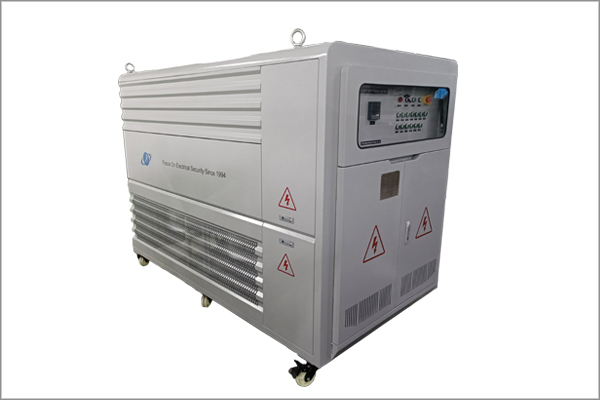Load Bank Maintenance and Calibration: Key Practices for Prolonging Equipment Lifespan and Common Misconceptions
Time:2025-04-01
In the field of industrial testing, load banks serve as precision power equipment whose performance stability directly impacts the accuracy of test data and the reliability of tested devices. However, many users often overlook maintenance and calibration, leading to premature equipment aging and increased failure rates. This article systematically outlines core maintenance essentials, analyzes common operational pitfalls, and proposes solutions through typical case studies.
I. Maintenance: Building a Full Lifecycle Protection System
1. Three Pillars of Daily Maintenance
Cleanliness Management
Key Point: Regularly clean inlet filters (recommended every 200 hours) to prevent dust accumulation from reducing cooling efficiency.
Case Study: A new energy vehicle manufacturer incurred over 50,000 RMB in repair costs after failing to clear internal dust in their load bank, causing power module overheating and burnout.
Cooling System Maintenance
Air-cooled Units: Inspect fan blades for 卡顿 (jamming) and lubricate bearings every 5,000 hours.
Liquid-cooled Units: Monitor coolant concentration (40%-50% ethylene glycol recommended) and replace coolant annually.
Fastener Inspection
High-Vibration Scenarios: Use a torque wrench to tighten terminal connections periodically (recommended torque: 8-10N·m for M8 bolts) to prevent localized overheating due to increased contact resistance.
II. Calibration: Ensuring Test Data Traceability
1. Standardized Calibration Process
Reference Equipment Selection
High-Precision Standard Sources: Recommended 0.05-class power calibration sources (e.g., FLUKE 5522A).
Environmental Conditions: Calibration should be conducted at 23±2°C with 45%-75% RH humidity.
Critical Parameter Calibration
Voltage/Current Accuracy: Errors must be controlled within ±0.1% FS.
Power Factor Compensation: Ensure ≥99% compensation accuracy across 0.2-1.0 power factor range.
2. Dynamic Calibration Techniques
Real-Time Waveform Comparison: Use oscilloscopes to synchronously monitor output waveforms against standard sources and correct phase deviations.
Nonlinear Load Compensation: Perform Total Harmonic Distortion (THD) calibration for rectifiers and similar nonlinear loads to ensure test current harmonics <5%.
III. Common Misconceptions and Solutions
1. Misconception 1: Over-Reliance on Automatic Protection Functions
Risk Analysis: A data center prematurely aged IGBT modules by 60% due to continuous 120% overloading, despite trigger overload protection.
Correct Practice: Strictly adhere to load derating curves (e.g., 10% derating at >30°C ambient temperature).
2. Misconception 2: Neglecting Environmental Impacts
Typical Scenario: A photovoltaic power station experienced capacitor failure at -20°C using a load bank without low-temperature heating modules.
Solution: Choose wide-temperature models (-40°C to 85°C) or activate preheating in cold environments.
3. Misconception 3: Calibration Equals Simple Zeroing
Faulty Operation: A laboratory achieved only 3% accuracy after performing zero-point calibration alone.
Standard Process: Complete 5-point full-range calibration (0%, 25%, 50%, 75%, 100%) with temperature drift compensation.
IV. Smart Maintenance Technology Trends
1. Predictive Maintenance Systems
Sensor Networks: Deploy vibration, temperature, and current sensors for real-time health monitoring.
AI Diagnostic Models: Train LSTM neural networks on historical data to predict power module remaining lifespan (accuracy >90%).
2. Cloud-Based Calibration Platforms
Remote Calibration: Support cross-regional calibration via 4G/5G networks using standard source commands.
Blockchain Authentication: Store calibration data on blockchain to ensure tamper-proof records compliant with ISO/IEC 17025.
V. Industry Standards and Compliance
Domestic Regulations: GB/T 3859.1-2013 requires load banks undergo type testing every 12 months.
International Certifications: ISO 9001 mandates equipment maintenance records be retained for at least 3 years.
Conclusion
Load bank maintenance and calibration represent a systematic engineering effort spanning the entire equipment lifecycle. Implementing standardized procedures and smart monitoring can reduce failure rates by over 70% and extend service life by 1.5 times. As IoT and AI technologies advance, load banks will transition from reactive maintenance to proactive health management, providing more reliable technical support for industrial testing. Enterprises should develop customized maintenance plans aligned with application scenarios to avoid the "operation-over-maintenance" trap and achieve true cost efficiency.
News Recommendation
-
 2024-09-11
2024-09-11TRIUMPH LOAD EXHIBITING AT Enlit Europe 2024 -BOOTH 7.H08
-
 2023-04-21
2023-04-21TRIUMPH LOAD EXHIBITING AT DATA CENTER WORLD GERMANY 2023-BOOTH F909
-
 2023-04-06
2023-04-06TRIUMPH LOAD EXHIBITING AT ELECTRIC POWER TECH KOREA 2023 – Booth G109
-
 2022-05-05
2022-05-05What is the role of ac load bank for power supply?
-
 2022-05-05
2022-05-05What is the role of the load bank?


